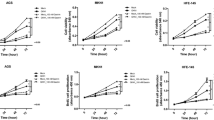Abstract
Two colorectal (HT29, LoVo) and one gastric (MKN45) human tumour cell lines were examined for their in vitro trophic response to human gastrin-17. MKN45 and HT29 responded by increased 75Se selenomethionine uptake to exogenous gastrin (139 +/- 5.5% and 123 +/- 3% of control values respectively) whereas LoVo showed no significant response to this hormone. When these same cell lines were grown as xenografts in nude mice, similar responses were seen to exogenously administered human gastrin-17 (10 micrograms mouse-1 day-1, subcutaneous injection). MKN45 xenografts showed a greater response to continuously administered gastrin (osmotic mini-pumps, (10 micrograms mouse-1 day-1) when compared to the same dose given via a subcutaneous bolus injection. The hormone-treated xenografts had a two-fold increase in tumour cross-sectional area and growth rate when compared to saline-treated controls. Dose-response studies revealed that 0.4 micrograms gastrin mouse-1 day-1 appeared to be the minimally effective dose. As gastric and colorectal tumour cells show a trophic response to gastrin, antagonists of the gastrin receptor may prevent this effect causing tumour stasis. The gastric tumour cell line, MKN45, is gastrin-responsive and would be an ideal model for screening potent receptor antagonists.
Similar content being viewed by others
Author information
Authors and Affiliations
Rights and permissions
About this article
Cite this article
Watson, S., Durrant, L. & Morris, D. Gastrin: growth enhancing effects on human gastric and colonic tumour cells. Br J Cancer 59, 554–558 (1989). https://doi.org/10.1038/bjc.1989.112
Issue Date:
DOI: https://doi.org/10.1038/bjc.1989.112
- Springer Nature Limited
This article is cited by
-
Incidence and treatment of metachronous gastric cancer after proximal gastrectomy
Surgery Today (2018)
-
Germline Mutation of the CCK Receptor: A Novel Biomarker for Pancreas Cancer
Clinical and Translational Gastroenterology (2016)
-
Expression of cholecystokinin receptors in colon cancer and the clinical correlation in Taiwan
Tumor Biology (2016)
-
A network map of the gastrin signaling pathway
Journal of Cell Communication and Signaling (2014)
-
The role of biologics in stomach cancer
Targeted Oncology (2008)




